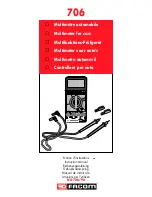
7
4. For continuity connect the test probes to the cable or circuit to be tested.
(Polarity is not important).
5. The AVO410 will emit a tone if continuity is below 500
Ω
/ .OL with no
tone will indicate either open circuit or continuity above 500
Ω
.
6. For diode testing connect the test probe tips to the diode or semiconductor
junction and note the reading.
7. Reverse the probe polarity by switching probe position and note this
reading.
8. The diode or junction can be evaluated as follows:
a. If one reading shows a value and the other reading shows .OL, the
diode is good.
b. If both readings show .OL, the device is open circuit.
c. If both readings are very small or zero, the device is shorted.
DCµA MEASUREMENTS (6000 µA max.)
1. Set the function switch to the DCµA position. (AUTO and DCµA will be
displayed).
2. Insert the black test lead into the COM jack and the red test lead into the
µA jack.
3. Remove power from circuit under test, then open circuit at a convenient
point where current is to be measured.
4. Connect the black test probe to the negative side of the circuit. Connect
the red test probe to the positive side of the circuit.
5. Carefully apply the power
6. Read the measured on the display.
7. Remove supply before removing test leads and reconnecting circuit.
CAPACITANCE MEASUREMENTS
WARNING:
To avoid damage to the instrument. Before testing, discharge the
capacitor/s to be tested.
1. Set the function switch to the capacitor position (AUTO and nF will be
appear on the display).
2. Insert the black test lead into the COM jack and the red test lead into the
capacitance jack.
3. Connect the test probe tips to the capacitor under test. Be sure to observe
the correct polarity if the capacitor is an electrolytic / polarised type. Red
to positive and black to negative.
4. Read the value on the display.
Summary of Contents for AVO410
Page 19: ...19 Fonctions 1 2 3 4 5 6...








































